Manufacturing uses manufacturing processes to change the geometry, characteristics, and appearance to create products.
What are Manufacturing Processes?
Manufacturing processes are used in large-scale manufacturing to create value-added engineering products and components using physical and chemical processes to change a starting material’s geometry, characteristics, and appearance.
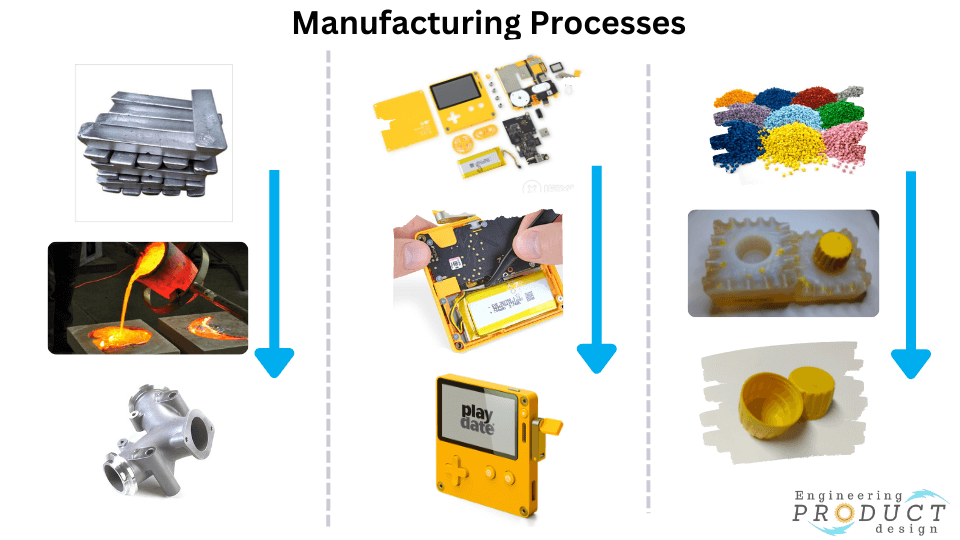
Manufacturers typically carry out the manufacturing processes as a unit operation, which means it is a single step in a series of steps required to transform a starting material into a finished product. Processing operations and assembly operations are the two basic types of manufacturing operations.
Types of Manufacturing processes
Manufacturing processes, as described above, can be divided into Processing and Assembly operations.

Processing operations – Manufacturing Processes
Processing operations add value by transforming a part from one state to another by changing its shape, property, appearance and surface texture with energy. Energy can take the form of mechanical, thermal, electrical and chemical. For example, milling an aluminium billet to achieve the required part or anodising a milled aluminium part would be a processing operation.
Although processing operations are primarily performed on distinct components, sometimes assembled parts, such as welded sheet metal fabrication, need processing like powder coating. Also, near-net shaping processing, such as sand casting or investment casting, would require some machining for features like threads, o-ring grooves, and bearing bores.
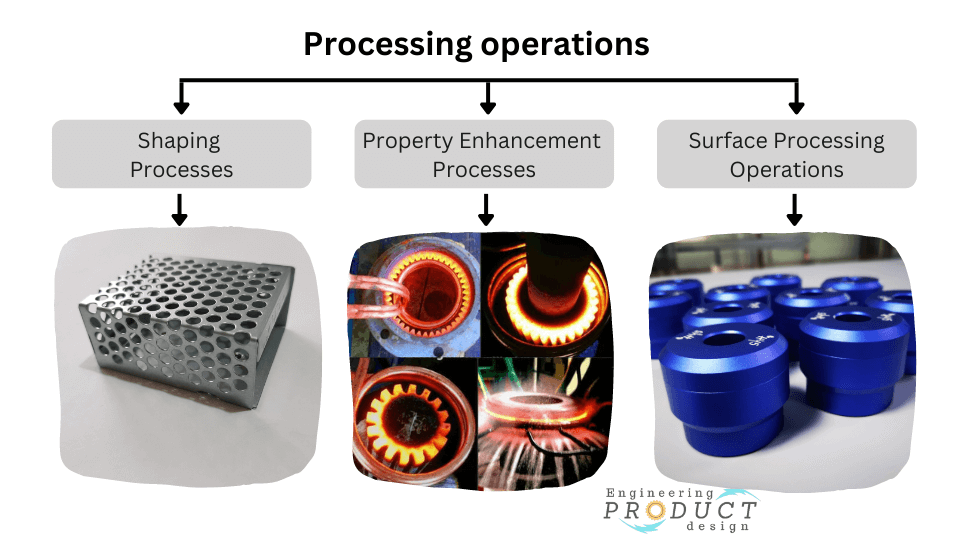
Shaping, Property enhancement and Surface processing operations are the three main types of Processing operations.
Shaping Processes
As the name suggests, this alters the geometry of the workpiece by primarily applying heat, mechanical force or a combination of both.
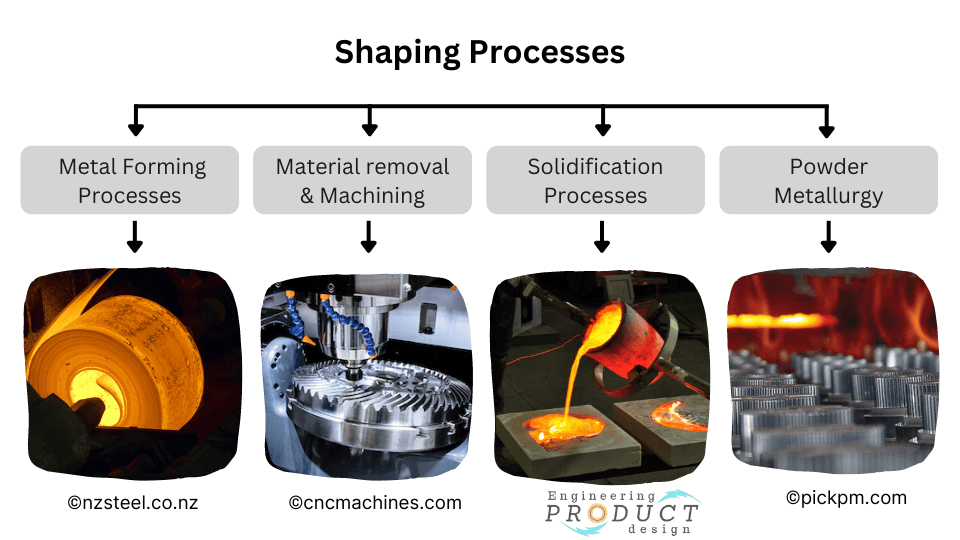
Solidification processes
Manufacturer melts raw materials such as plastic pellets, metal or quartz sand to transform them into semi-fluid or liquid. This melted material then cools down and solidifies to form a 3d shape. This process can be used to process almost all materials from metal, plastic, ceramic, and Glass. Once they are in a liquid state, they can be pushed or poured into a mould. The new AM technology also falls into this category, where the material is heated and added layer by layer to create a 3D object.
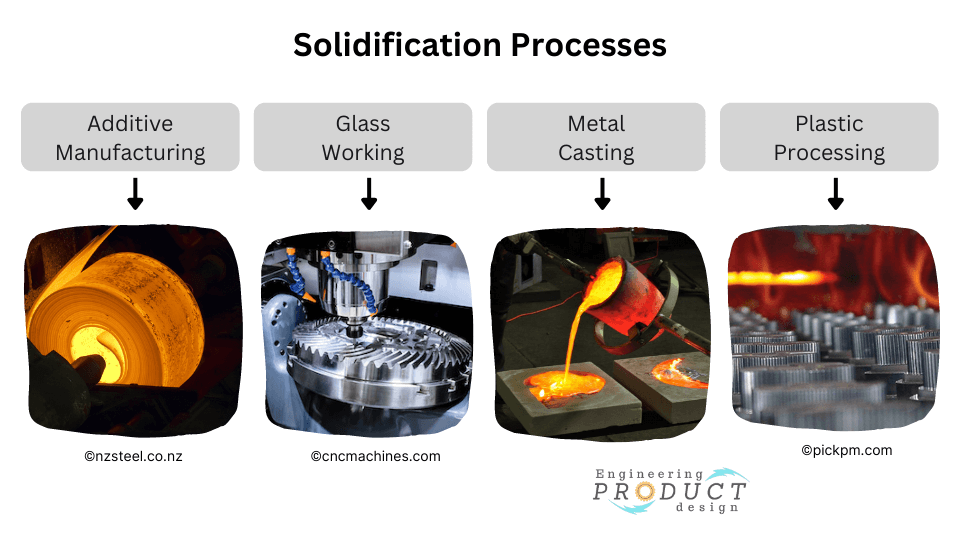
Glass working, Metal casting, Additive manufacturing and Plastic processing are the four main types of solidification processes.
Metal casting
Metal casting is a process where the molten metal is fed into a mould by gravity or force, solidifying it into the mould shape part called “casting”. Numerous shape-casting methods are available, such as Sand casting, Die casting and Investment casting, making it one of the most versatile manufacturing processes. Casting can produce complex part geometries with both external and internal shapes.

Die casting, Gravity casting, Centrifugal casting, Sand casting, Shell moulding, Plaster mould, ceramic mould, investment casting, and lost foam casting are some of the metal casting processes.
Detailed articles on Metal castings
- Complete guide to Metal casting
- What are Sand casting and its applications
- Introduction to Centrifugal casting
- Investment casting guide
- Difference Between Sand Casting, Die Casting And Investment Casting
Glass working
Glass is processed by melting and shaping it, either in moulds or by blowing. They are commercially manufactured in an almost unlimited variety of shapes, such as flat sheets, plates, rods, tubing, bottles, vases, eyeglasses and glass fibres.
Guide to the glass production process
Additive manufacturing
The fundamental principle of Additive Manufacturing technology is that it directly uses CAD-generated 3D models to fabricate a three-dimensional object by adding layer upon layer of material and fusing them. These are also known as 3D printing technologies.
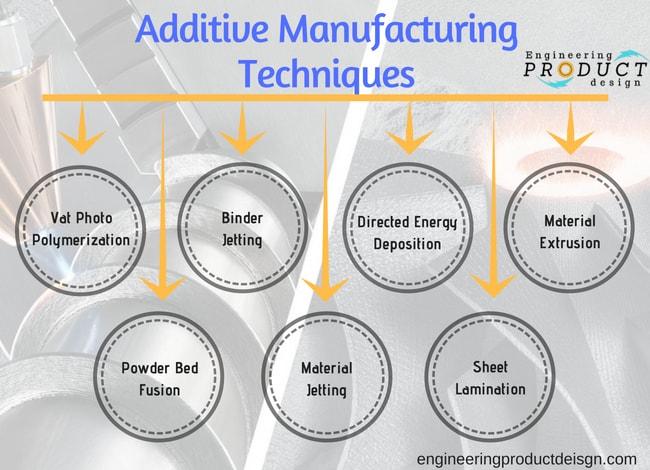
Vat photopolymerisation, Material Extrusion, Material Jetting, Binder Jetting, Powder bed fusion, directed energy deposition, and Sheet lamination are the seven main additive manufacturing technologies. The table lists some of the most common types and subtypes below.
| Main AM Category | Technology types |
| Vat photopolymerisation | Stereolithography (SLA), Direct Light Processing (DLP), Continuous Direct Light Processing (CDLP) |
| Material Extrusion | Fused deposition modelling (FDM) |
| Material Jetting | PolyJet technology, NanoParticle Jetting (NPJ), Drop-On Demand (DOD) |
| Binder Jetting | Binder Jetting |
| Powder bed fusion | Selective Laser Sintering (SLS), Selective Laser Melting (SLM), Direct Metal Laser Sintering (DMLS) |
| Directed energy deposition | Laser-based DED, Electron beam-based DED, Plasma or Electric arc-based DED |
| Sheet lamination | Laminated Object Manufacturing (LOM), Composite Based Additive Manufacturing (CBAM) |
Plastic processing
Plastic processing converts raw materials of plastics into finished products by forming them into desired shapes. These bulk plastics are available in resin, granules, pellets, powders, sheets, preforms, or fluids. In addition, plastic materials can contain various additives, impacting their properties and processability.
Following initial formation processing, the plastic part may be subjected to various processes such as welding, adhesive bonding, machining, and surface decoration.
- Injection moulding
- Reaction injection moulding
- Liquid Silicone Rubber & LSR Injection moulding
- Blow moulding
- Extrusion
- Compression moulding
- Transfer moulding
- Thermoforming
Particulate processing – Powder metallurgy
Powder metallurgy is a method of metal solidification that involves heating compacted metal powders to temperatures just below their melting points to create complex rigid 3D components.
Metal or ceramic powders serve as starting materials. Although these two materials differ significantly, particle processing techniques used to shape them are very similar.
Some of the widely used Powder metallurgy processing techniques are Press & Sinter process, Isostatic pressing, Hot Isostatic Pressing (HIP), Powder Injection Moulding (PIM), and Metal Injection moulding (MIM).
Metal Forming
Metal forming, sometimes known as the Deformation process, refers to a broad range of manufacturing processes that use plastic deformation to alter the shape of a malleable metal to create the required form. The material must be sufficiently ductile to prevent fracture during deformation, and the manufacturer uses forces larger than the material’s yield strength to mould and deform the workpiece.
There are two types of Metal forming
- Bulk deformation
- Sheet metalworking or Sheet metal forming
Bulk deformation
Bulk deformation processes are typically characterised by significant deformations and massive shape changes, with a relatively small surface area-to-volume ratio. The term bulk refers to work parts with a low area-to-volume ratio. Cylindrical billets and rectangular bars are common starting work shapes for these processes. Manufacturers heat the material before forming to a temperature below the melting point to promote ductility.
Metal Rolling, Metal forging, Metal extrusion, and drawing are the four basic types of bulk deformation processes.
Detailed articles on Metal forming techniques
- Complete guide to Metal forming
- What are Metal extrusion and its applications
- Introduction to Metal forging
Sheet metalworking
Sheet metalworking, also known as sheet metal forming, is the cutting and forming of relatively thin metal sheets, strips, and coils. Bending, sheet metal drawing, and shearing are the three basic types of Sheet metalworking processes.
Sheet metalworking processes are classified into three categories: bending, sheet metal drawing, and shearing.
- Shearing or Cutting
- Bending
- Drawing
Complete guide to Sheet Metal forming
Material removal process
As the name suggests, the material removal process removes material or surface modifications to achieve the desired feature, shape and size. They are a family of shaping operations commonly called machining operations. CNC machining is the most common and used extensively to machine metal such as Stainnless steel and Aluminium alloys.
Near-net or net-shape parts produced by metal casting, forming, and shaping processes frequently necessitate additional machining operations before the product is ready for use.
Machining processes are classified into three main categories:
- Conventional machining – CNC machining
- Turning
- Drilling
- Milling
- Abrasive processes
- Grinding
- Advanced machining processes
- Electrical Discharge Machining (EDM)
- Electrochemical machining
- Thermal energy processes
- Chemical machining
- Plasma cutting
- Laser cutting or Laser Beam Machining
- Hydrodynamics – Water cutting machining
Typical parts in a car manufactured using machining operations are Threaded fasteners, door locks, threaded holes, keys, engine block and crankshaft.
Property enhancing processes – Heat treatment
Heat treating is a sequence of treatments that use heat to change a metal’s or alloy’s properties. These treatments are used for various reasons, the most important of which is to control mechanical properties such as hardness, ductility, strength, toughness, and internal stresses.
Heat treatment processes are divided into three categories: Hardening, annealing, and surface hardening
Surface Processing operations
Cleaning, surface treatments, coating and deposition processes are surface processing operations.
Cleaning involves Chemical and mechanical operations to remove surface contaminants such as dirt, oil and rust from the surface.
Surface treatments are mechanical and physical operations that change the surface of a part in some way, such as improving the finish or impregnating it with atoms of foreign material to alter its chemistry and physical properties. Processes such as sandblasting, aqua blasting, and shot peening falls into this category.
Coating and thin film deposition processes apply a material coating to the work part’s exterior surface. Electroplating, aluminium anodising, painting, and porcelain enamelling are all common coating processes.
Physical and chemical vapour deposition creates fragile coatings of various substances.
Assembly operations – Manufacturing Processes
The second primary manufacturing process is assembly operations. Assembly operations involve joining two or more components to create a new entity called an assembly using permanent joining processes like welding and binding and Mechanical fastening using screws and rivets.
For example, the assembly could use self-tapping screws to hold the plastic housings together and adhesive to hold the lenses for the VR headset.
Assemblies could be either fully mechanical entities such as a gearbox and mechanical power transmission units or electro-mechanical assemblies such as a VR headset.
The assembly components are permanently or semi-permanently connected using permanent joining processes or mechanical fastening.
Permanent joining process
Adhesive bonding, welding, soldering, and brazing are permanent joining processes. They connect components that cannot be easily disconnected.
Welding
Welding is a manufacturing process in which two components are fused using heat, pressure, or both to form a joint as the parts cool. This manufacturing process is typically performed on metals and thermoplastics. The finished welded joint is known as a weldment.
Brazing and Soldering
Brazing and soldering are the same: they melt the filler metal but not the base materials. Through capillary action, the liquid filler metal wets the base materials. When the liquid filler metal solidifies, it bonds to the base materials, forming a joint.
Adhesive bonding
Adhesive bonding is joining two surfaces together, typically by forming a smooth bond. Bonding may entail using glue, epoxy, or one of a variety of plastic agents that bond via solvent evaporation or curing via heat, time, or pressure.
Mechanical fastening
Mechanical fastening is the most common way for many materials to be joined in the industry and can connect two or more parts in a joint that can be easily disassembled. Initially used for metal joining, it is now widely used to join metals, plastics, and other materials. Permanent and nonpermanent industrial fasteners are the two main types and can be grouped into the following groups.
- Threaded fastening
- Permanent fastening method
Threaded fastening in this category includes screws, bolts, and other threaded fasteners. Other mechanical assembly techniques, such as rivets, press fitting, and expansion fits, create a more permanent connection, falling under the Permanent fastening method.